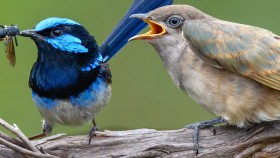Fairy wrens vary egg size to increase survival rates
A new study has shown that the female Superb Fairy-Wren has the ability to change the size of the eggs it lays in a biological feat which could buffer against the effects of climate change.
Lead researcher Dr Naomi Langmore from The Australian National University (ANU) said the study suggested the Superb Fairy-Wren could lay larger eggs to give the chicks a better chance of survival in warmer temperatures.
“Superb Fairy-Wren chicks have poorer growth rates during heatwaves,” said Dr Langmore from the ANU Research School of Biology.
“We were worried that the projected temperature extremes in Australia could lead to high chick mortality or poorer long-term survival. But we found that these birds have a surprising way to deal with this.”
Superb Fairy-Wrens are cooperative breeders, which means breeding pairs are assisted in rearing their chicks by non-breeding helpers. These helpers are young males who stay behind to help if they can’t find a mate.
The research, published in The Royal Society journal Proceedings B, found that provisioning of chicks by helpers allows the mother to invest less energy in egg production when conditions are good, resulting in smaller eggs.
“By conserving resources when conditions are good the mothers can invest heavily in egg production when the chicks face high temperatures,” Dr Langmore said.
“Producing larger and more nutrient rich eggs in hotter environments results in larger chicks, which may give the chicks a better chance of survival by buffering against weight loss.”
The research, carried out over 10 breeding seasons in Campbell Park in the Australian Capital Territory, found that breeding pairs without helpers were not able to change the size of their eggs the way those with helpers could.
“Cooperative breeding is common in Australia and sub-Saharan Africa, where the climate can be tough on species,” she said.
“One of the implications of our research is that animals that utilise this type of breeding could have a better chance of dealing with climate change.”








